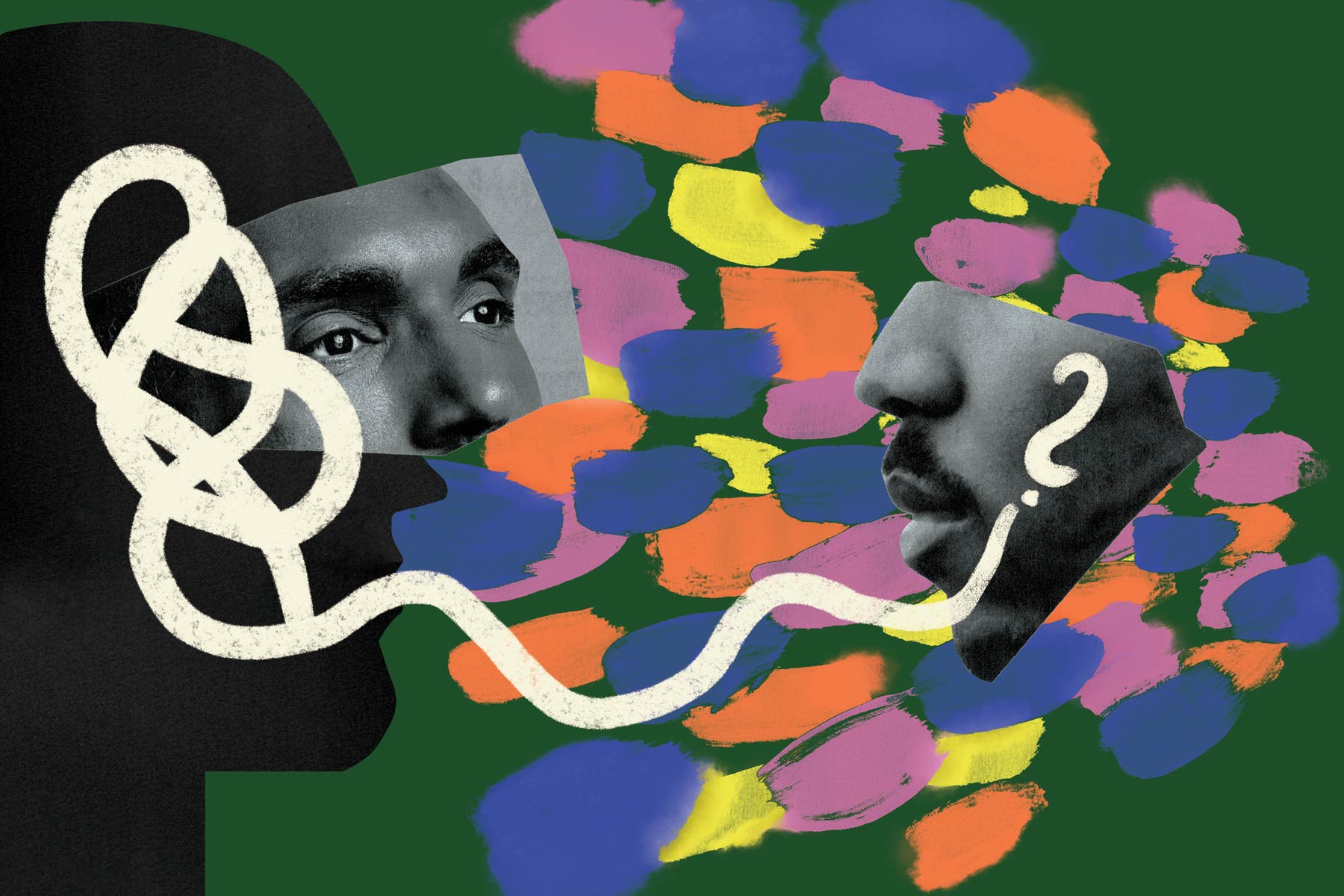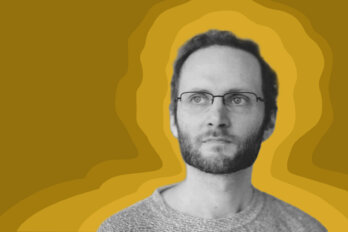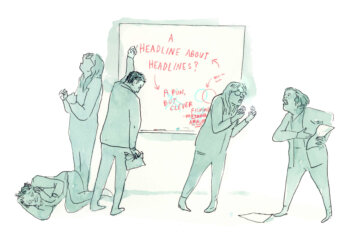For most of my life, I’ve lived alone. This means that spontaneous conversations don’t flare up the way they do when you’re driving your kid to their friend’s house and end up talking about septum rings. Conversations for people who live alone, regardless of relationship status, must be actively initiated by some party, often through technological means.
Armchair scientist that I am, I resolved to keep a log of my first conversation of the day with another human. Then I would scan the data to see what patterns emerged.
My first conversation of the day with a human was with a couple of gym employees. It was early in the new year. I got to the university gym right when it opened, at 7 a.m., so I could have my pick of machines and not have to bench in other people’s sweat. Following my chiropractor’s recommendation, I did three sets of squats, three sets of bench, then I looked around and couldn’t find the equipment for the last exercise, so I went up to the employees and asked, Hey, is there a lat machine somewhere?
You mean for lat pull-downs or rows?
Lat pull-downs.
Yeah. She pointed to the intimidating section of the gym where guys wore contraptions on their waists, wrists, and ankles. The lat machine was in use. I wasn’t going to wait around for the guy using it to finish and then adjust the weight down while he snickered internally.
I asked, What’s in the room behind this one?
Mostly free weights.
And upstairs? Is there a lat machine in the upper gym?
For lat pull-downs? I’m pretty sure, yeah. Yeah, by the rowing machines.
Okay, thanks.
That was it. I didn’t talk to anyone else at the gym until my squash partner arrived and he told me about a project he was working on, a book on banned books, the history of the Catholic church censoring books—more than books, every form of human expression, he said.
This conversation had potential.
When was this? I asked. Dark Ages?
No, no. We’re looking at early 1600s until 1960 something.
It sounds like something from 300 years before the Renaissance, at least.
Well, it’s really the printing press. That’s what made all the censorship necessary.
From a content level, it was terrifically exciting. My squash partner would devote chapters to Ulysses and The Handmaid’s Tale. Another to Oscar Wilde and the perceived corrupting influences on sexuality. He told me about book bans and a local school board’s decision to purge all books published before 2008.
We were having a pretty masculine interaction. We panted through the conversation between games and gulps of water, suppressed pleasant emotions, and whacked the ball against the wall while thinking about what the other had said.
Despite its unusual spaced-out rhythm, the squash conversation seemed important because the subject was important. We often transfer the subject matter to the conversation itself. Is it possible to have a silly conversation about something serious? Of course, but you’d notice the incongruity. I felt satisfied because we were both interested in the topic. Although it was his topic, as much as a topic can be owned, I was curious about it for its own sake.
The squash conversation was also satisfying because I could find parallels between my partner’s expressed thoughts and my suppressed thoughts. Every once in a while, I could punctuate or turn the conversation by saying, That reminds me of x, or, I was working on something about y. Together we built ideas.
At around 8:30, we hit pause on the conversation to go sit in front of our screens in silence. We’d continue it in a week.
Reality check. I was not my squash partner’s first conversation. He had connected with his family through Good morning and Hurry up in the shower and Do you want oatmeal or cereal and It’s too cold for that coat. While the substance of such conversations may not be memorable or interesting, oh to wake up with voices around you, asking about your dreams.
What makes a good conversation?
My mother would say, Getting my point across.
One of my grad students would say, Feeling listened to.
My most touchy-feely friend would say, Preserving or improving a relationship. A sense that we got closer.
I can’t say for sure. I didn’t ask any of them. But I reckon that no one would include being a good listener. At best, they might frame the role of listening as something more active: I feel satisfied when I’m helpful, when I can comfort someone well.
Enough speculation. After a bit of warm-up, I asked someone in a hotel lounge, What makes you feel satisfied in a conversation?
The man had removed his shoes and was wearing thick wool socks.
He said, Reciprocity. Genuine interest in whatever the other is saying. He paused, then added, After a good conversation, you come away with some energy.
And I almost asked, Do you play squash?
Some time later, while zoned out in a meeting, my thoughts naturally turned to another form of the question.
What makes a good meeting?
In a structured environment, a good meeting feels like multiple viewpoints are presented, weighed, selected, and that there is consensus on future action. Time clips along.
As for a bad meeting, that’s easy. It’s stagnant, dominated by a few voices, recycles the same point, stagnant, dominated by the same voices, regurgitates a similar point, stagnant.
A good conversation takes time. If it’s really good, it dilates time. When it is restricted to a short, fixed duration, the speakers become intent on making their points before the gong sounds. They listen strategically for points of disagreement and wait for moments to interject with reiterations of their position. Speakers report more than engage. They never lay down the burden of their intention to receive the gift of another person’s words. The conversation is cinched into an alley between two buildings that ends at a brick wall. A good conversation opens up toward the horizon.
This kind of undefined time has been eroded to the point that we find it uncomfortable. We can blame the doctrine of productivity, which is not new. The devil, for a long time, has been finding work for idle hands to do. Work. The value of keeping busy is only wearing a new word, productivity, doubtlessly linked to the word product, which itself points to capital. The other culprit behind the erosion of conversational time is, paradoxically, distraction. We are actively distracted by pings, reels, data, listicles, flavours of chips. Conversations require transcendental leisure, like Thoreau sauntering around for four hours every day, in the same way that quality work requires sustained periods of concentration rather than multitasking. Philosopher Byung-Chul Han makes a good point about multitasking. It is not an advanced quality: it “does not represent civilizational progress. . . . Multitasking is commonplace among wild animals. It is an attentive technique indispensable for survival in the wilderness. . . . An animal busy with eating must also attend to other tasks. For example, it must hold rivals away from its prey. It must constantly be on the lookout, lest it be eaten while eating.” Productivity and distraction are twin evils.
A good conversation is built on curiosity and attention. This means lending all of our senses to people. A little plug: if you want to improve these two capacities, read poetry. Every detail matters, every switchback at the end of a line resensitizes your attention. The language and world of poetry are strange enough to make you ask questions.
The question is the clearest sign of curiosity. It promotes spontaneity and originality. I bristle at superficial rote questions, although I long for people to be genuinely curious about me. We need the social forms of politeness—how are you, fine—to get us through the ice, to keep us together long enough for our defences to break down, but a good conversation moves beyond rote questions and responses. Charles Duhigg, author of Supercommunicators, suggests ways of reframing simple questions into deep ones, thereby opening up a conversation for more than factual answers and increasing the chances of connection. “Are you married?” becomes “Tell me about your family.” “Where did you go to high school?” becomes “What advice would you give a high schooler?” And you can simply add “what’s the best” to ordinary questions to zhuzh them up: Where do you live? → What’s the best thing about your neighbourhood? Where did you go to college? → What’s the best part of college? And the problematic Where are you from? → What’s the best thing about where you grew up? That last one feels strategic and deceptive.
Curiosity is necessary if you are to connect with others. Perhaps you’ve met the kind of man who speaks only in declarative sentences. He possesses a certainty that masquerades as confidence but is really underdeveloped curiosity. I wish it were fatigued curiosity, but it’s not. This man’s incurious nature is symptomatic of brutishness and brutality.
There’s a limit to our attention, no? How long does it take for people to stop caring? If a politician or government engaged in a war knew that the media news cycle for an acute event is on average four days—for a war, ninety days—then they could just wait us out.
Attention is about more than how long we can concentrate, though. It is about the sensitivity of our receptors. Screen-writing coach Robert McKee, in his book Dialogue, asserts that conversations are made up of the said, the unsaid, and the unsayable. The said is obvious: words that come out of your mouth. It’s the surface. The unsaid is deliberately withheld by the speaker. Perhaps there’s a consequence to speaking; perhaps it’s wiser, safer, or sexier to imply something rather than stating it. The contrast between the said and the unsaid gives us personal drama in each conversation. We actively monitor fluctuations of trust and predict our partner’s reactions to determine whether our thoughts dare break the surface and be put into words. Finally, the unsayable resides at a deeper, more private place than the unsaid. The conscious self may not even have access to this secret self that nevertheless creates inconsistencies between what one believes about oneself (I’m not sexist) and how one behaves (well . . . ). Deep attention within a conversation is being able to understand the said and also sending out sonar signals to pick up the unsaid and the unsayable.
On the second morning of the experiment, my phone rang. I almost didn’t answer. I didn’t want to begin my day of glorious conversations with this one, a logistical checklist for event planning. According to my notifications, it should have been my second conversation of the day; I had a missed call from a pre-construction condo salesman.
I was not satisfied. The phone calls felt like substitutions for conversations rather than conversations themselves. A young writer told me that when she’s away and calls home and someone places the phone close to the dog’s face, the dog looks confused and goes to the door to wait for her to come home. When you call someone, you expect them to come. Of course, after the average phone call, there’s no guarantee that someone will join you afterward. But if the conversation is really good, you feel like you’ve left your house and are with your friend in some alternate dimension.
But most phone calls feel like a diminished form of contact, a peach with the skin peeled.
New twist on the experiment. My understanding of conversation was too narrow. I had to get with the times, open up, and observe the first interaction of the day. My previous first conversations felt more like transactions than interactions. Now I resolved to take note of the first exchanges I had with another human.
That day, the first interaction was a text I sent.
9:52 a.m.: I was thinking about how many fish you’ve killed in your lifetime. You’re like a fish terrorist.
No reply until later that day. That’s the problem with asynchronicity. Too much time can elapse between one utterance and another. You’re left hanging. I couldn’t count that as a conversation. Rather, I was engaged in a peculiarly modern way of being: waiting for my phone to manifest a human, snacking on human interactions throughout the day.
I was not satisfied.
A day later, the first interaction was a phone call to give someone good news. I was happy for them, but I was not satisfied.
The following day, I went almost the entire day working from home, not talking to anyone else until I got to the chiropractor’s at 5 p.m. He told me that his partner had surprised him for their anniversary. She took him to a two-star Michelin restaurant in Toronto to get sushi. When he arrived, he found only two couples. I asked, Did she buy out the restaurant? Are you dating a Saudi princess? He said that he was shocked too. The restaurant let in only six people at a time. Exclusive, I said. He smiled. Maybe she loves you, I said. My internal conversation, though, was wondering whether he and his partner were aligned in love languages, whether a grand gesture from her was landing as a significant signal of affection to him. Then he described the food. There were unusual body parts involved. I felt us diverging here (not a foodie), but I liked his excitement. He was working on my wrist. Holding my hand to do so. I asked about his partner, Did they meet at the gym? They did. How long had they been together? A year. He told me that he planned Valentine’s Day. She planned the anniversary. Now her birthday was coming up, and he wasn’t sure what to do. She’s won this, I said and gave bad bro advice: Your best bet is to lower her expectations from here on.
I got home and said to the big palm in the kitchen, Your leaves are wilting. I said it without using my voice. I thought it at the plant and it thought back at me, I want water and for you to raise my soil level, but don’t worry about it, I know you’re busy.
To summarize the data, I had four types of conversations: chat, phone, face to face, with myself as projected onto a plant. It struck me that this was not simply the effect of modernity on the structure of my life, but maybe this was a foretaste of what the last years of one’s life feel like.
I discovered that my first conversations came late in the day or should be forgotten altogether. My first interactions were typically through a device. In a real experiment, this might be the point where the ethics board pulled the plug on the experiment because the emerging result would hollow out the participant, which is to say, could I bear to be disabused of the image of myself as leading a full, rich life with deep connections and stimulating conversations?
No, we would continue to the wintry conclusion.
First interaction, the next day, still in bed: I sent a WhatsApp message to a friend about a Taiwanese semiconductor company that was expanding to Japan. He answered immediately from his bed on the other side of the world. There was some real-time back and forth. Parts of my brain lit up.
The next day, I changed the experiment when I realized that my first conversation wouldn’t be until 2 p.m. Instead of noting my first conversation, or first interaction, I would note the first voice I heard that was not mine.
I was living inside of a John Cage composition.
I heard many things that day. I heard the wheeze of the garbage truck as it made its way down the street, pausing in front of each house to overturn the bins. I heard myself moving around. The toothbrush on my teeth, my feet on the floorboards, a lot of gurgling in my gut, the sound of the toaster lever, of apples being sliced, the fridge opening and closing, oat milk in the bowl. I heard notifications come in on my phone, but I didn’t hear a voice until the guys downstairs woke up and addressed each other in Turkish.
This brings us to the end of our scientific process, rigorously applied in grade-five-purpose-hypothesis-materials-method-observation-conclusion kind of way. Nevertheless, I did not like what the experiment was revealing about my life.
No, no, the problem could not be with me. The design of the experiment was flawed. I should observe the last conversation of the day. Maybe that’s when I was at my most scintillating. Or forget the first and last. I should seek out the best conversation of my day. Or. Or.
Conclusion: I was isolated. I do not mean lonely. I had many kinds of relationships, from lifelong to exclusively textual ones, that could be called upon to deliver a dollop of dopamine, but I was nevertheless sequestered from the people in those relationships. We all meant each other well. Yet my friends had become contacts.
One of the overlooked downsides to living alone is that one literally has no one to talk to. As an introvert, I took a long time to identify that as a source of my malaise, though I spotted it easily in my mother, who seems to need someone to talk to, who, like her mother, is afraid of becoming someone who talks to herself. I didn’t perceive a need in myself for conversation. But once it became apparent how underused my voice was by noon, I couldn’t stop noticing. Did this conversational infrequency set me at a social disadvantage? Remember how, after the pandemic, we were all awful at making small talk with each other at our initial gatherings? Maybe some people were always living in a conversational pandemic, perpetually emerging from a drought of loving voices.
Excerpted from What I Mean to Say: Remaking Conversation in Our Time, copyright © 2024 by Ian Williams and the Canadian Broadcasting Corporation. Reproduced with permission from House of Anansi Press, Toronto.





